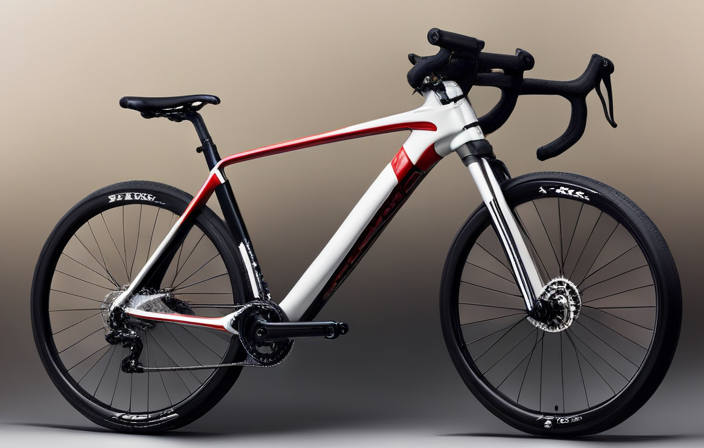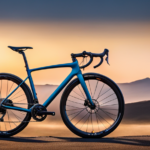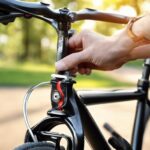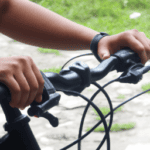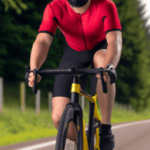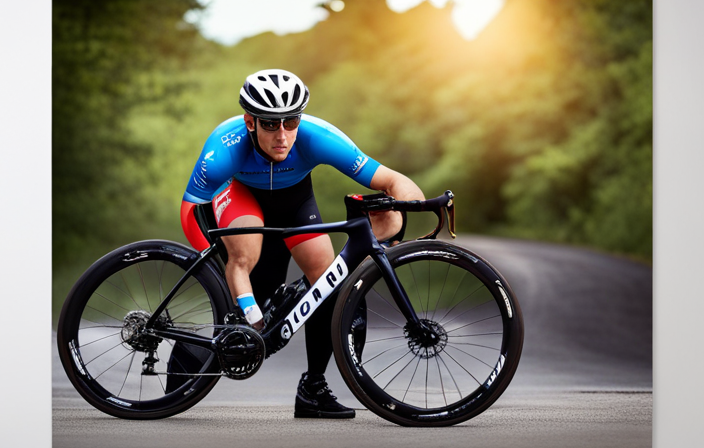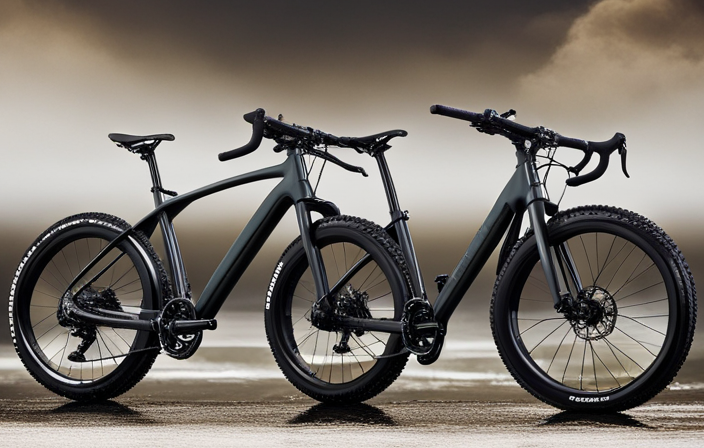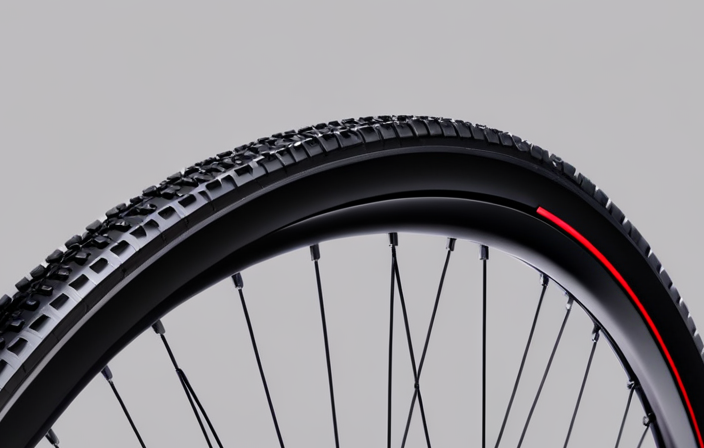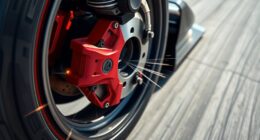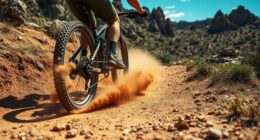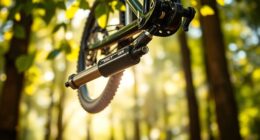Positioning the handlebars on your gravel bike is essential for optimizing comfort, control, and performance. It may be a difficult task to find the ideal position, but don’t worry! This article will lead you through the process with accuracy and thoroughness.
By understanding the importance of handlebar positioning, considering your riding style and body measurements, and making necessary adjustments along the way, you’ll be able to enjoy all the benefits that come with a properly positioned handlebar.
So let’s dive in and find your ideal gravel bike handlebar setup!
Key Takeaways
- Narrower handlebars are more suitable for road cycling, while wider handlebars are better for off-road cycling, providing increased stability and control.
- Consider body measurements and flexibility when determining handlebar positioning, including reach, drop, width, and evaluating flexibility for optimal riding position adjustment.
- Choose the right handlebar type and width based on material options (aluminum, carbon fiber, steel), matching shoulder width, and considering the desired balance between stability/control and aerodynamics.
- Adjust handlebar reach, drop, and height by loosening stem bolts, sliding handlebars for comfortable reach, finding the optimal drop for balance between aerodynamics and comfort, and fine-tuning adjustments through test riding to achieve a comfortable and safe riding experience.
Understand the Importance of Handlebar Positioning
You need to understand the importance of handlebar positioning when it comes to gravel bike riding. Proper handlebar positioning can greatly impact your body alignment, comfort, and efficiency on the bike.
When your handlebars are positioned correctly, it allows for optimal control and stability, reducing strain on your upper body and preventing fatigue during long rides.
Body alignment is crucial in maintaining a good riding posture. The position of the handlebars should be such that your hands are comfortably resting on them without having to stretch or bend too much. This ensures that your shoulders are relaxed and your back is in a neutral position, minimizing the risk of discomfort or injury.
Comfort is another key factor affected by handlebar positioning. With the right placement, you can achieve a natural hand grip that reduces pressure points and numbness in your palms. Additionally, proper positioning can also help prevent wrist pain or strain caused by excessive bending or twisting.
Efficiency is enhanced when you have full control over your bike’s steering and maneuverability. With properly positioned handlebars, you can easily navigate through rough terrains while maintaining stability and balance.
Determining your riding style and preferences will further guide you in finding the ideal handlebar position for yourself. Now let’s move on to understanding how to determine your riding style and preferences without compromising comfort or efficiency.
Determine Your Riding Style and Preferences
Discovering your riding style and preferences will help you determine the most comfortable way to set up your gravel bike’s handlebars. When it comes to bike fit, handlebar width plays a crucial role in ensuring optimal comfort and control while riding. To find the right handlebar width for you, consider the following factors:
| Riding Style | Narrower Handlebars | Wider Handlebars |
|---|---|---|
| Road Cycling | Provides better aerodynamics and maneuverability | Offers increased stability and control |
| Off-Road Cycling | Enables easier navigation through tight trails | Enhances stability on rough terrain |
Your riding style will dictate whether you should opt for narrower or wider handlebars. If you primarily ride on roads or enjoy fast-paced cycling, narrower handlebars may be more suitable as they offer improved aerodynamics and maneuverability. On the other hand, if you frequently venture off-road or tackle rough terrains, wider handlebars provide greater stability and control.
Consider your body measurements and flexibility when determining the ideal handlebar position. By incorporating these factors into your decision-making process, you can ensure that your gravel bike’s handlebars are set up in a way that maximizes comfort, efficiency, and overall riding experience without compromising on safety.
Consider Your Body Measurements and Flexibility
Take into account your body measurements and flexibility to ensure the ideal fit for your handlebars. Proper body alignment plays a crucial role in maximizing comfort and performance on your gravel bike. Here are four key considerations to guide you:
-
Reach: Measure the distance between your saddle and handlebars. A comfortable reach allows for proper weight distribution and reduces strain on your back.
-
Drop: Determine the height difference between the saddle and handlebars. This affects your riding position, with a lower drop providing a more aggressive stance for increased aerodynamics.
-
Width: Consider the width of your shoulders when selecting handlebars. Optimal width promotes better control and stability while preventing discomfort or strain in the upper body.
-
Flexibility: Evaluate your range of motion, particularly in the hips, back, and shoulders. This helps determine if you need a more upright or aggressive riding position based on your flexibility level.
By understanding these factors, you can make necessary bike fit adjustments to achieve an optimal riding experience on gravel terrain.
Now let’s move on to choosing the right handlebar type and width for further customization.
Choose the Right Handlebar Type and Width
To customize your gravel riding experience, it’s important to select the appropriate type and width of handlebar. When choosing a handlebar for your gravel bike, you should consider the material options available.
Handlebars can be made from various materials such as aluminum, carbon fiber, or steel. Each material has its own characteristics in terms of weight, stiffness, and durability. Aluminum handlebars are lightweight and affordable but may not absorb vibrations as well as carbon fiber ones. Carbon fiber handlebars provide excellent vibration dampening properties but can be more expensive. Steel handlebars offer a classic aesthetic and are known for their durability.
In addition to material options, finding the right handlebar width is crucial for comfort and control while riding on gravel terrain. The width of the handlebar should match your shoulder width to ensure proper upper body alignment during rides. A wider bar provides stability and control over rough surfaces while a narrower bar offers better aerodynamics for faster rides on smoother paths.
Once you have chosen the appropriate type and width of handlebar, the next step is to adjust the reach and drop of the handlebars to further optimize your riding position. This will be discussed in detail in the subsequent section about how to adjust the reach and drop of the handlebars without compromising comfort or performance.
Adjust the Reach and Drop of the Handlebars
To optimize your riding experience, you should adjust the reach and drop of your handlebars without compromising comfort or performance. Properly adjusting the handlebar height can enhance bike handling and reduce strain on your body. Here are some key steps to adjust the reach and drop of your gravel bike handlebars:
- Loosen the stem bolts: Start by loosening the bolts that hold the handlebar stem in place.
- Adjust reach: Slide the handlebars forward or backward to find a comfortable position that allows you to maintain a natural grip without overstretching.
- Check elbow bend: Bend your elbows slightly when gripping the brake hoods, ensuring a relaxed and efficient riding posture.
- Find optimal drop: Experiment with different heights by raising or lowering the stem until you find a balance between aerodynamics and comfort.
- Test ride and fine-tune: Take your bike for a test ride after each adjustment to assess how it feels. Make small adjustments as needed until you achieve an ideal fit.
By following these steps, you can optimize handlebar reach and ensure a comfortable riding position.
In the next section, we will discuss how to find the ideal height for your handlebars without compromising safety or stability.
Find the Ideal Height for Your Handlebars
Finding the ideal height for your handlebars is crucial for achieving a comfortable and safe riding experience. When it comes to gravel bike handlebars, finding the right handlebar reach and adjusting the height are important factors to consider. The table below provides a visual representation of different handlebar heights based on rider preferences.
| Rider Preference | Handlebar Height |
|---|---|
| Aggressive | Low |
| Neutral | Medium |
| Relaxed | High |
To find your ideal handlebar height, start by sitting on your bike with your hands on the brake hoods. Your upper body should feel relaxed and in a natural position. If you prefer an aggressive riding style, opt for a lower handlebar height. For a more neutral riding position, go for a medium height. And if you prefer a more relaxed posture, choose a higher handlebar height.
Once you have found the ideal height, fine-tune the handlebar angle to further enhance comfort and control. This will ensure that you can enjoy your gravel biking adventures with confidence and ease.
[SUBSEQUENT SECTION: ‘Fine-Tune the Handlebar Angle’]Fine-tune the Handlebar Angle
Once you’ve found the ideal height for your handlebars, it’s important to fine-tune the angle for optimal comfort and control.
Fine-tuning the handlebar angle involves adjusting its position relative to the stem. To begin, loosen the bolts on the stem and rotate the handlebars until you find a position that feels natural and comfortable. It’s crucial to ensure that your wrists are in a neutral position when gripping the handlebars.
When fine-tuning the handlebar angle, consider your riding style and preferences. If you prefer an aggressive riding position with more weight on your front wheel, try angling the handlebars slightly downward. On the other hand, if comfort is your priority and you want a more relaxed riding position, angling them slightly upward may be beneficial.
Finding the optimal handlebar reach is also essential for comfort and control. This can be achieved by adjusting both the angle of your stem and length of your bike’s top tube. A shorter reach will put less strain on your upper body, while a longer reach can provide better aerodynamics.
Remember to test and adjust your handlebar position based on how it feels during rides. Making small adjustments at a time allows you to find that sweet spot where you have maximum control without sacrificing comfort or efficiency.
Test and Adjust Your Handlebar Position
Testing and adjusting your handlebar setup is crucial for achieving optimal comfort and control while riding. To find the optimal position for your gravel bike handlebars, start by making small adjustments to the height and reach. Begin by loosening the stem bolts and raising or lowering the handlebars to a position that feels comfortable for your body. Once you have found a good height, focus on the reach of the bars. You want them to be within easy reach without causing strain in your arms or shoulders.
After fine-tuning the height and reach, it’s time to test out your new handlebar position. Take your bike for a short ride around a safe area, paying close attention to how it feels as you navigate different terrains and make turns. Notice if there are any areas of discomfort or if you feel like you’re not in full control of the bike.
Based on these test rides, make further adjustments if necessary until you find a position that offers both comfort and control. Pay attention to how your hand placement and grip feel during these rides as well, as this will lead us into our next section about optimizing hand positioning.
Transition: Now that we have found an optimal position for our handlebars, let’s explore how paying attention to hand placement and grip can further enhance our riding experience.
Pay Attention to Your Hand Placement and Grip
Make sure to focus on where you place your hands and how you grip the handlebars for an enhanced riding experience. Proper hand placement is essential for maintaining control and stability while riding a gravel bike.
When positioning your hands on the handlebars, there are three key grip techniques to consider:
-
The first technique is the neutral grip, where your hands are positioned in a relaxed manner with fingers lightly wrapped around the handlebars. This allows for easy maneuverability and quick adjustments during rides.
-
The second technique is the hoods grip, where your hands rest on the brake hoods located near the top of the handlebars. This position provides a balanced posture and allows for efficient braking and shifting.
-
The third technique is the drops grip, where your hands grasp onto the lower part of the handlebars called ‘the drops.’ This position offers increased aerodynamics and stability when cycling at higher speeds or encountering rough terrain.
By mastering these different hand placements and alternating between them as needed, you can optimize your control over the bike in various riding conditions.
Additionally, considering adding bar tape or grips to improve comfort during long rides. These accessories provide extra cushioning and reduce vibrations, allowing for a more enjoyable riding experience overall.
Consider Adding Bar Tape or Grips for Comfort
To enhance your riding comfort, you might want to consider adding bar tape or grips for a more enjoyable experience. When it comes to choosing between bar tape and grips, there are a few factors to consider.
Bar tape is typically made of padded material that wraps around the handlebars, providing cushioning and shock absorption. Grips, on the other hand, are usually made of rubber or silicone and provide a more direct connection between your hands and the handlebars.
When installing bar tape or grips, it’s important to find the right handlebar angle for your specific riding style. A slight upward angle can help alleviate pressure on your wrists and promote a more natural hand position. Additionally, make sure the bar tape or grips are securely fastened to prevent any slipping during rides.
In conclusion, adding bar tape or grips can greatly improve your comfort while riding a gravel bike. Consider experimenting with different options to find what works best for you. If you’re unsure about how to properly install them or adjust your handlebar angle, seek professional help if needed.
Seeking professional help can ensure that you have the optimal setup for your gravel bike.
Seek Professional Help if Needed
If you’re unsure about how to properly install them or adjust your handlebar angle, it’s worth seeking professional help if needed. Although adjusting the position of your gravel bike handlebars may seem like a simple task, it is important to ensure that it is done correctly for optimal comfort and performance. Seeking professional assistance can provide you with expert guidance and knowledge to achieve the best results.
A professional bike fitter will take into account your personal preferences, riding style, and body dimensions when positioning your handlebars. They will assess factors such as reach, drop, and width to determine the most suitable setup for you. This level of precision ensures that you are in a comfortable riding position while maintaining control over your bike.
Professional help can also be beneficial if you have any specific concerns or physical limitations that need to be addressed. The expertise of a bike fitter allows them to make adjustments that cater specifically to your needs.
Once you have sought professional help and had your handlebars positioned correctly, the next step is to ride and evaluate your handlebar position. This will allow you to fine-tune any minor adjustments based on how they feel during actual riding conditions without compromising safety or comfort.
Ride and Evaluate Your Handlebar Position
After seeking professional help, it’s important to ride and evaluate how your new handlebar setup feels. Evaluating handlebar ergonomics is crucial to improving overall cycling performance. Here are some key factors to consider when assessing the feel of your handlebars:
-
Comfort: Pay attention to any discomfort or pain in your hands, wrists, or arms during the ride. A properly positioned handlebar should provide a comfortable grip and minimize strain on these areas.
-
Stability: Notice if you feel stable and in control while riding. Unwanted movements or excessive vibrations can indicate a need for adjustments.
-
Handling: Assess how well you can maneuver the bike with the new handlebar position. Smooth turns and responsive handling are signs of an optimal setup.
Evaluating these aspects will help determine if your current handlebar position suits your needs. If necessary, small adjustments can be made to fine-tune the setup further and optimize your riding experience.
Transitioning into the next section about making small adjustments as necessary, remember that even minor tweaks can make a significant difference in achieving an ideal handlebar position for maximum comfort and performance.
Make Small Adjustments as Necessary
After riding and evaluating your handlebar position, you may find that some adjustments need to be made to achieve the perfect fit. It is important to make gradual changes rather than large ones, as this will allow you to assess the impact of each adjustment on your overall comfort and performance.
Start by considering the height of your handlebars. If you feel too stretched out or cramped, try raising or lowering them in small increments until you find a position that feels natural and allows for optimal control.
Next, pay attention to the width of your handlebars. A wider or narrower stance can affect your stability and maneuverability on different terrains. Again, make small adjustments and test how they feel during rides before settling on a final width.
If you are unsure about making these adjustments yourself, it’s always helpful to seek expert advice from a bike fitting specialist or experienced riders who can provide valuable insights based on their knowledge and experience.
Remember that finding the right handlebar position is an ongoing process that may require multiple iterations. So take regular breaks, listen to your body’s feedback, and continue fine-tuning until you achieve the most comfortable and efficient setup for your gravel biking adventures.
In our next section about ‘take regular breaks and listen to your body’, we will discuss the importance of rest intervals during long rides and how attentive self-care contributes to enhancing overall performance.
Take Regular Breaks and Listen to Your Body
During long rides, it’s crucial to take regular breaks and listen to your body for optimal performance. Riding a gravel bike can put strain on various parts of your body, including your hands, wrists, and shoulders. By taking regular breaks, you give these areas a chance to rest and recover, reducing the risk of discomfort or injury.
When it comes to listening to your body, pay attention to any signs of fatigue or discomfort. If you start feeling numbness or tingling in your hands or fingers, it may be a sign that your handlebars need adjusting. Take a break and assess the situation. You might need to adjust the angle or height of your handlebars to achieve a more comfortable position.
Additionally, don’t ignore any pain or soreness in your neck, back, or shoulders. These could also be indicators that your handlebars aren’t properly positioned. Taking regular breaks allows you time to evaluate how your body is responding and make necessary adjustments.
By listening to your body and taking breaks when needed, you can ensure that you’re riding in a position that maximizes comfort and minimizes strain. This will allow you to enjoy the benefits of a properly positioned handlebar without compromising on performance.
Enjoy the Benefits of a Properly Positioned Handlebar
To fully experience the advantages of a correctly adjusted handlebar, it’s essential to enjoy the benefits of improved comfort and enhanced performance. Proper handlebar positioning for different riding styles is crucial in achieving optimal results. Finding the optimal handlebar height and angle can make a significant difference in your overall riding experience.
Here are five key benefits of a properly positioned handlebar:
-
Improved comfort: A well-positioned handlebar reduces strain on your wrists, shoulders, and neck, allowing for a more comfortable ride.
-
Enhanced control: The right handlebar position enables better bike handling, especially when navigating challenging terrains or corners.
-
Increased power transfer: Proper handlebar positioning optimizes your body alignment, facilitating efficient energy transfer from your legs to the pedals.
-
Reduced fatigue: By minimizing unnecessary stress on your body, you can ride longer without feeling fatigued, enabling you to tackle longer distances with ease.
-
Customizable fit: Adjusting the height and angle of the handlebars allows you to tailor them precisely to your body’s needs and preferences.
To find the optimal positioning for your gravel bike’s handlebars, consider factors such as your riding style and personal preferences. Experiment with different heights and angles until you find what feels most comfortable and provides maximum control. Remember that small adjustments can make a big difference in improving both comfort and performance on your rides.
Frequently Asked Questions
Can I use any type of handlebar for my gravel bike?
Yes, you can use different types of handlebars for your gravel bike. The type of handlebar you choose will depend on your personal preferences and riding style.
There are various options such as drop bars, flat bars, or even aero bars.
Proper handlebar positioning is crucial as it directly affects your comfort, control, and overall performance on the bike. It helps to reduce strain on your wrists and shoulders while allowing for efficient power transfer and maneuverability.
How do I know if my handlebars are at the correct height?
To determine if your handlebars are at the correct height, you can start by measuring the handlebar reach. This is done by measuring the distance between the saddle and the handlebars.
Adjusting the handlebar angle is also crucial in achieving proper positioning. Ensure that your wrists are in a comfortable and neutral position when gripping the bars.
Fine-tuning these adjustments will help optimize your riding experience on your gravel bike.
What are the signs that indicate my handlebars need to be adjusted?
If my handlebars are giving me indications that they need adjustment, such as discomfort or strain in my wrists, arms, or shoulders, it’s clear that something is not right. These signs of handlebar adjustment need should not be ignored.
To properly adjust gravel bike handlebars, I need to consider factors like height and angle to ensure optimal comfort and control. Taking the time to make these adjustments can greatly enhance my riding experience.
Is it possible to make handlebar adjustments without professional help?
Yes, it is possible to make handlebar adjustments without professional help. However, it is important to have knowledge of handlebar adjustment techniques and the benefits of professional handlebar fitting.
Proper positioning of gravel bike handlebars involves adjusting the height, angle, and reach to ensure optimal comfort and control while riding.
While some adjustments can be made by yourself, seeking professional assistance can provide a more precise fit tailored to your specific body mechanics and riding style.
What are some common mistakes to avoid when positioning gravel bike handlebars?
When it comes to gravel bike handlebar positioning, there are a few common mistakes that riders should avoid.
One of them is setting the handlebar height too low, which can lead to discomfort and limited control.
Another mistake is angling the handlebars too far forward or backward, affecting steering responsiveness.
To properly adjust the handlebar height on a gravel bike, start by loosening the stem bolts and experimenting with different positions until you find the one that offers optimal comfort and control.
Conclusion
In conclusion, finding the perfect position for your gravel bike handlebars is crucial for a comfortable and efficient ride.
Just like the handlebars serve as the connection between you and your bike, they also symbolize the harmony between your body and machine.
By taking into account factors such as riding style, body measurements, and flexibility, you can achieve optimal positioning.
Remember to make small adjustments as needed and listen to your body’s cues.
With a properly positioned handlebar, you’ll experience enhanced control and enjoyment on every gravel adventure.
